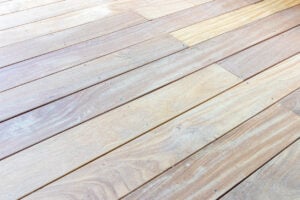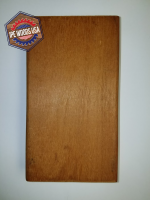Cumaru Wood Decking
| SPECIES | Shrinkage Radial to Grain | Shrinkage Perpendicular to Grain | Differential Shrinkage | Volumetric Shrinkage |
| Cumaru | 5.40% | 8.40% | 3.00% | 13.30% |
Understanding Cumaru Wood for Outdoor Applications
Cumaru, commonly known as Brazilian Teak, is a hardwood from Northern South America prized for its durability and aesthetic appeal. This guide provides a detailed look at cumaru’s properties, uses, and benefits, especially focusing on decking, siding, and fencing.
Properties of Cumaru Wood
Cumaru wood is known for its robustness and unique coloration, which ranges from a rich medium to dark brown with possible reddish or purplish hues and streaks of yellow and green. The wood features an interlocked grain with a medium texture and a waxy feel, emitting faint cinnamon or vanilla-like scents during installation.
Uses of Cumaru Wood
– Decking: Cumaru is a popular choice for decking because of its extreme durability and natural resistance to rot, decay, and insect attack. Its dense structure provides a solid platform that can withstand harsh weather conditions and heavy foot traffic, making it ideal for outdoor spaces.

– Siding: As siding, cumaru offers an attractive and long-lasting solution. It stands up well against the elements, maintaining its integrity and appearance over time. Cumaru siding adds a layer of insulation and can help regulate indoor temperatures due to its dense nature.
– Fencing: Cumaru’s strength and resistance to natural decay also make it suitable for fencing. It provides a secure, durable barrier that maintains its condition without the need for frequent maintenance or chemical treatments.
Benefits of Using Cumaru Wood
– Durability: One of the most significant advantages of cumaru is its longevity. This wood can last over 50 years in outdoor applications with minimal maintenance, thanks to its natural properties.
– Resistance to Pests and Decay: Cumaru has superior resistance to termites, mold, and other pests compared to softer woods. Its ‘Class A’ fire rating also makes it a safer choice in areas prone to wildfires.
– Eco-Friendly: Cumaru is a sustainable option for homeowners looking for eco-friendly building materials. It is 100% biodegradable and does not require harmful chemical treatments to maintain its durability.
– Aesthetic Appeal: With its natural beauty, cumaru adds an elegant and warm look to any outdoor setting, enhancing the overall aesthetics of a property.
Considerations When Working with Cumaru Wood
While cumaru has many benefits, there are a few considerations to keep in mind:
– The wood’s density can make it challenging to work with, often requiring pre-drilling and the use of special hardware.
– Its high oil and silica content may interfere with glues and can dull cutting tools more quickly than softer woods.
– Cumaru’s weight adds to the complexity of handling and installation, especially in large projects like siding.
For more details on cumaru wood and its applications, visit The Wood Database.
Detailed Overview of Cumaru (Brazilian Teak) Hardwood
Cumaru, also known as Brazilian Chestnut, is a robust and dense wood imported from Brazil. It is renowned for its toughness and resistance to environmental elements, making it an excellent choice for outdoor applications like decking, siding, and fencing.
Description of Cumaru Wood
The heartwood of Cumaru features a medium brown color with distinctive tan shades that create a warm, welcoming tone. This hardwood has an irregular, somewhat interlocked grain and a coarse, wavy texture. Due to its high density, Cumaru is highly resistant to termites and decay.
Scientific and Mechanical Properties
– Janka Hardness: 3,200 pounds, indicating a very high resistance to denting and wear.
– Strength (MOR): 24,800 psi, showcasing its robustness.
– Stiffness (MOE): 3,050,000 psi, reflecting its ability to withstand stress and strain.
– Density: 1,080 KG/m3, which contributes to its durability and strength.
– Color: Starts as reddish-brown or purplish-brown and shifts to light-brown to yellowish-brown upon exposure. Sapwood is generally yellowish-brown.
– Photosensitivity: Cumaru darkens upon exposure to light, enhancing its color richness over time.
– Shrinkage: Tangential Shrinkage of 8.4% and Radial Shrinkage of 5.4%, typical for hardwoods of this density.
Working and Drying Characteristics
– Cumaru is rated as easy to air season but can sometimes check and warp; it dries uniformly and rapidly.
– Working with Cumaru can be challenging due to its high density and oily nature, making it difficult to saw or bore and poor for gluing.
Applications of Cumaru Wood
– Due to its durability, Cumaru is used in a variety of heavy-duty applications such as cogs, flooring, decking, turnery, bearings, tool handles, railroad crossties, and heavy construction.
– We offer Cumaru in both unfinished and prefinished hardwood floors, with available widths of 3″, 4″, and 5″. For more detailed product information, please see our product catalog.
Tree and Geographic Information
The Cumaru tree is a member of the Leguminosae family and can reach up to 160 feet in height with trunk diameters just over 3 feet. It is native to a range of South American countries including Venezuela, Colombia, Brazil, Peru, Bolivia, and The Guianas.
For further details about Cumaru wood and its properties, visit The Wood Database.
We also have an informative video on Cumaru wood here.
Showing all 7 results



